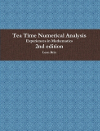- About MAA
- Membership
- MAA Publications
- Periodicals
- Blogs
- MAA Book Series
- MAA Press (an imprint of the AMS)
- MAA Notes
- MAA Reviews
- Mathematical Communication
- Information for Libraries
- Author Resources
- Advertise with MAA
- Meetings
- Competitions
- Programs
- Communities
- MAA Sections
- SIGMAA
- MAA Connect
- Students
- MAA Awards
- Awards Booklets
- Writing Awards
- Teaching Awards
- Service Awards
- Research Awards
- Lecture Awards
- Putnam Competition Individual and Team Winners
- D. E. Shaw Group AMC 8 Awards & Certificates
- Maryam Mirzakhani AMC 10 A Awards & Certificates
- Two Sigma AMC 10 B Awards & Certificates
- Jane Street AMC 12 A Awards & Certificates
- Akamai AMC 12 B Awards & Certificates
- High School Teachers
- News
You are here
Tea Time Numerical Analysis

Publisher:
Lulu.com
Publication Date:
2016
Number of Pages:
366
Format:
Paperback
Edition:
2
Price:
25.23
Category:
Textbook
[Reviewed by , on ]
Kyle Riley
12/14/2019
Open textbook options have greatly increased in recent years and allow for more experimentation and innovation than what can be available under traditional forms of textbook publishing. A frequent challenge with open textbooks is that errors and inaccuracies are more common than in a commercially published text. Tea Time Numerical Analysis: Experiences in Mathematics (2 ed.) by Leon Brin is a clean and well-organized book with a professional layout that rivals the quality one might find in a commercially published textbook. The author states a desire to contribute a freely available introduction to numerical analysis textbook appropriate for an audience focused on the underlying mathematics. I believe the author has accomplished his goal and I only wish he had the desire to develop a textbook that would align more with the larger and broader audience of undergraduate students that often take a numerical methods course in engineering and science.
The Tea Time inclusion in the title has the intent to label the book as more conversational in style where students and a faculty member might be discussing a topic over tea. The book also includes crumpets that are small inclusions of history, or other details, to help illuminate the subject at hand. The use of Tea Time might not be a successful marketing strategy, but an open textbook does not suffer the same burdens in marketing as commercial publications. The book does include most of the traditional topics one encounters in a one semester introduction to numerical analysis class with: error, interpolation, root finding, basic numerical methods for calculus, and methods for ordinary differential equations. The book includes many of the proofs one would expect in a mathematics driven numerical analysis course and the author makes fine use of these tools within the interpolation sections in particular. I did find it surprising the book does not formally include the definition of local truncation error when discussing numerical methods for solving ordinary differential equations, which is a rather standard and prominent feature for textbooks in the field. The book also includes useful sets of homework exercises along with select answers in combination with worked solutions.
A very nice addition to the text is the use of Octave and Maxima. The use of open software is a natural complement to an open textbook. The book frequently uses Octave and provides good support on how to program using Octave. The book keeps the level of programming at a modest level, but it would still be useful for a student to have a background that includes some computer programming in order to handle the content covered in the text and the associated exercises. The use of Maxima in the text is limited, but essential
in the areas where it is used.
This book does establish a unique niche in the literature. There are currently very few open textbooks in the area of Numerical Analysis and the target of mathematics students is also unique. The traditional books that cater to a mathematics driven audience in numerical analysis are massive tomes with examples including: Numerical Analysis (9 ed.) by Burden and Faires; Numerical Analysis: Mathematics of Scientific Computing by Kincaid and Cheney; and An Introduction to Numerical Analysis (2 ed.) (Wiley, 1989) by Atkinson. The Tea Time book is a nice brief introduction that deserves recognition for adding to the genre with a philosophy of openness that is a benefit to community. The book is published under the creative commons license that does allow free usage in addition to a GitHub repository.
Kyle Riley teaches at the South Dakota School of Mines and Technology and has taught several semesters of Introduction to Numerical Analysis to students in engineering and science.
The table of contents is not available.
- Log in to post comments




